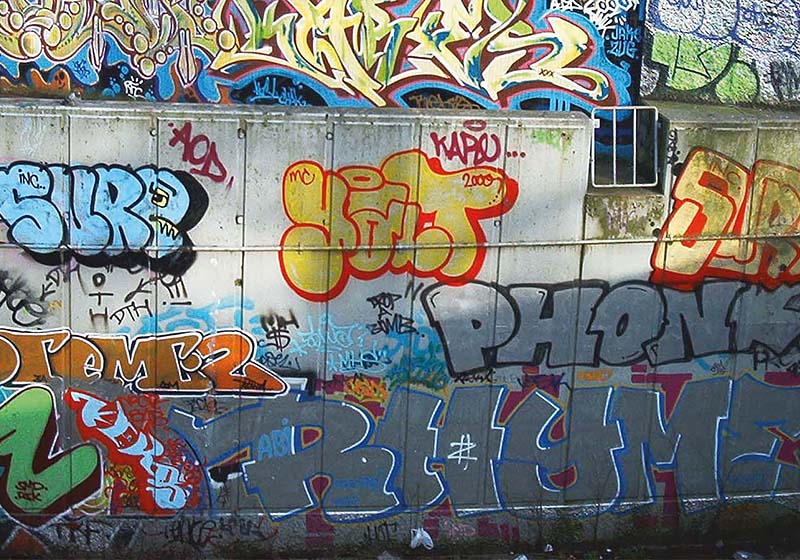The following story is an exerpt taken from the book Amsterdam Graffiti: The Battle of Waterloo written and designed by Dutch Graffiti Library, Remko Koopman and Hein S. Published by Stadsuitgeverij Amsterdam in 2004, Amsterdam Graffiti: The Battle of Waterloo was the first official publication concerning graffiti art in The Netherlands.
The Battle of Waterloo tells the story of the rise and fall of Amsterdam’s most infamous illegal graffiti artist refuge which was located in the middle of the city centre. For years (1978-2003) the abandoned underpasses and the wastelands surrounding the Waterlooplein and Mr. Visserplein were a thorn in the flesh of the City of Amsterdam. At the same time, though, this area attracted graffiti writers from all over Europe and turned into a pilgrimage place for creative youngsters with unruly behaviour. In the beginning of 2003 the legendary ‘Waterlooplein Hall of Fame’ was forced to disappear when a gentrification project called ‘Tun Fun’ turned the area into a playground for kids. Which, ultimately, put an end to all ‘battles’ graffiti artists fought amongst themselves, against local authorities and the city police. It particularly put a stop to the battle between the various styles of graffiti art that dominated the walls of the underpasses of the Mr. Visserplein for a period of 25 years. Graffiti is cursed and at the same time admired by many people. Fact is that the development of this underground subculture, which spawned many of todays renowned contemporary art figures, would be impossible without the existence of a major architectural failure turned desolate urban area such as the Mr. Visserplein.
The takeover
In March 1985, alderman Michael van der Vlis (City of Amsterdam, Town Planning and Traffic) decided to close down the pedestrian underpasses beneath the Mr. Visserplein using huge iron gates. Amsterdam’s city centre would finally be relieved from the terrifying labyrinth of corridors and tunnels that formed the traffic square. The end was near for this part of town, which many people labeled as ‘an extremely unhealthy environment’ and ‘a terrifyingly inhuman area’. A sigh of relief was heard when the bill ‘Amsterdam asks for it: an active policy against sexual violence’ finally paid off. This bill contained a large amount of suggestions to increase the security in the city centre. The closing of the underpasses was the start of a big discussion between the city council and the people living in that neighbourhood of the city. The main point of discussion was: ‘What to do with the immense space underneath the Mr. Visserplein?’ On January 5th 1983, the readers of a local newspaper called Amsterdam’s Stadsblad were invited to send in suggestions of what to do with the abandoned space of the traffic square. The best ideas would be presented to the city council. A wide diversity of proposals were submitted. Everything ranging from an underground disco – in which cars would drive in a glass tunnel right through the dancing crowd – to letting different music groups manage the place were suggested. The quest for a new destination would go on for many more years.
The square was exposed
During those years the square was exposed to the elements of the city climate and turned into a desolate wasteland. The tiled underground tunnels turned into a meeting place for street punks, homeless people and junkies. After the closing, the homeless saw this surrealistic area as free lodging, a zero-star hotel with ever changing graffiti wallpaper. Around 1978 the first graffiti started to appear on the walls of the square. At this time the underpasses of the Mr. Visserplein were still open for public. The graffiti was mainly written by kids that were related to the punk movement. Society, which at that time was characterized by unemployment and selfish nihilism, got a kick in the ass by the streetwise hardcore punks with anger and a lot of times also heroine running through their veins. Poems and slogans criticizing society, signed with a pseudonym, dominated the walls. The Mr. Visserplein gradually changed from a hyper modern traffic square into a tarnished refuge for graphic ‘artists’, punk-poets and other outsiders. Slowly a subculture with its own rules and expression was born. Punkgraffiti, later taken over by the Hiphop-based New York variation of this artform, had found fertile ground to grow roots. The dark image of the tunnel complex and the risky location in the middle of a busy traffic roundabout were the reasons why most ‘regular’ people avoided the place as much as possible. It were these same aspects that magnetically attracted the graffiti writers like moths to the light.
Text by Remko Koopman (artist / graphic designer from Leiden, The Netherlands)
Published before in “Amsterdam Graffiti the Battle of Waterloo – 2004”
